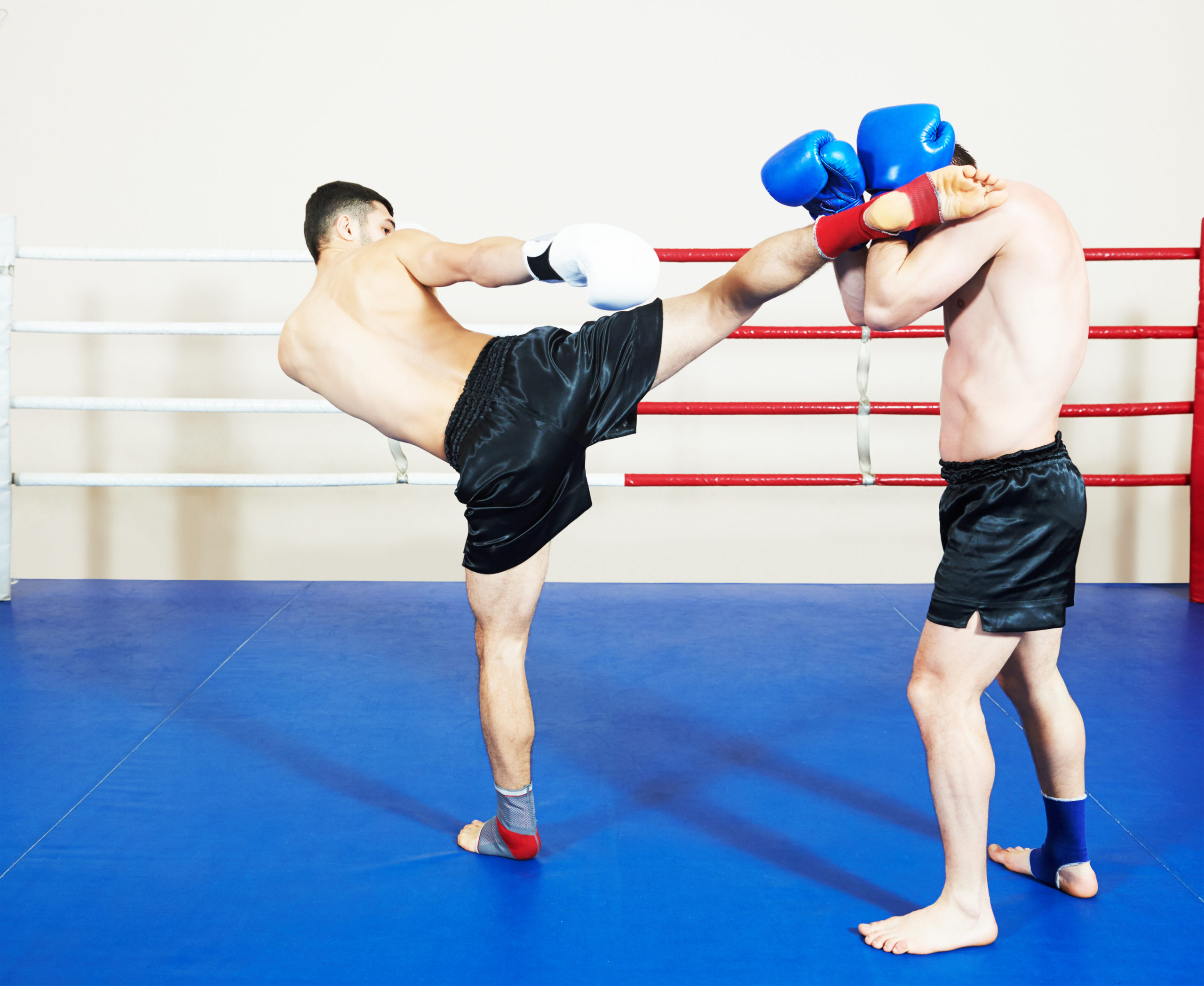The question mark kick is an advanced technique used in different striking arts including, muay thai, karate, Taekwondo, kickboxing and MMA.
This kick can be a spectacular KO kick and is a very effective and dangerous technique.
In this post we cover:
- Important tips for executing the ‘?’ kick
- Different versions of the ‘?’ kick in muay thai, MMA, TKD and Karate
- Setting up the kick
- High level strikers who use the kick in fights
- How to gain the required flexibility
- How to drill the ‘?’ kick technique
The kick requires good hip mobility in order to rotate the hip to strike downward with the kick. It also requires flexibility, dexterity and leg strength standing on the rotating leg.
Across different martial arts this kick has different names.
Important Tips for Executing
- Deception and ‘selling’ the placement of you kick is important.
- Rotation of the foot on the standing leg is essential
- Your hips should have the same initiating motion for the question mark kick as when you throw a low kick, body kick or teep.
- Mid-way through the kick rotate your hips and trajectory of your shin/foot area to strike downwards (neck area is a good target)
Different Variations Across Martial Arts Styles
Muay Thai Variation
This kick has different names across other martial arts but in Thai this kick is known as Tae kot and is named due to the downward striking action of the technique.
It is one of the many different types of kicks in muay thai.
Excellent nak muay who execute this technique effectively in a fight include Saenchai and Lerdsila.
MMA Question Mark Kick
This technique is not used to a great extent in MMA as of yet.
However Holly Holm, Luke Rockhold and other fighters such as Israel Adesanya and Stephen Wonderboy Thomson do have this technique in their arsenal of strikes.
The technique in MMA is basically the same as in kickboxing and muay thai.
K-1 Kickboxing ‘Brazilian’ Kick
The tae kot in muay thai is known as the Brazilian Kick in kickboxing.
The name is derived from the influence of Brazilian karetaks such as Francisco Filho and Feitosa.
These Brazilian kareteka used the Brazilian kick effectively in K1 competition.
Karate Question Mark Kick
The question mark kick is used in karate where the technique is known as the ‘dropping roundhouse kick’ or Otoshi Mawashi Geri in Japanese.
This technique is shown in the video below.
According to http://the-martial-way.com/ this particular technique has many variations in Karate that include:
- Kubi Mawashi Geri (Neck Roundhouse Kick)
- Tate Kubi Geri (Vertical Neck Kick)
- Kesa Geri (Diagonal Kick)
- Kubi Geri (kick neck)
- Sankaku Geri (triangle kick)
- Mawashi Otoshi Geri (dropping Roundhouse kick)
- Otoshi Mawashi Geri (dropping Roundhouse kick)
- Jodan Tate Mawashi Kubi Geri (upper- Vertical Roundhouse Neck Level kick)
- Haisoku Soto Oroshi Mawashi Geri Seashi (outside Descending Instep Roundhouse kick)
- Jodan Uchi Oroshi Geri (upper-Level inside Descending kick)
- Jodan Soto Mawashi Geri (upper-level outside roundhouse kick)
The question mark kick utilizes a downward motion coming down onto the target. This requires good hip mobility and flexibility in order to achieve this downward angled motion of the kick.
Taekwondo Variation
In Taekwondo this kick is a more advanced technique also.
It is used in point sparring and Taekwondo competition.
In the taekwondo variation, less focus is on striking with the shin as in muay thai and kickboxing.
The point can be awarded for this kick if your the end of your toes touch your opponents head area.
Question Mark Kick Set Up
The question mark kick requires deception and tricking your opponent and gaining a reaction from your opponent in order to land this deceptive technique.
The question mark kick can be set up by throwing and preferably landing the low kick, teep or body kick.
By threatening with a kick you previously landed such as a low kick (Saenchai style), you fake the low kick and extend up and over to strike down with the question mark kick.
Strikers Who Use the Question Mark
In muay thai Saenchai is known as a great exponent of the question mark kick. Using his great flexibility and hip dexterity, Saenchai likes to land the kick after landing a few low kicks and getting his opponent wary of the low kick first.
Lerdsila is another great exponent of this kick has landed this technique in high level competition.
Glaube Feitosa made this kick famous through K-1 where he scored KO victories using his Brazilian Karate style. The influence of Feitosa and his use of this advanced technique are the basis of the naming of this technique the ‘Brazilian’ kick.
Holly Holm has a notable KO win over Beth Correia at UFC Fight Night 111 in 2017. Holm landed the KO by faking the body kick and coming up and over to score the KO with the question mark kick.
Flexibility for the Kick
As stated the question mark kick requires a certain amount of hip mobility and flexibility in order to execute effectively.
Glabe Feitosa who made this kick famous and orginated the name ‘Brazilian’ kick is quoted as saying:
“this kick demands a lot of leg and hip stretching, and practice. You have to adjust your body, perfectly turn your opposite foot, and train it every day in your strategy, in sparring. “
Some common problems people face when learning this kick are:
- Difficulty in getting the kick high enough before rotating the hip to strike down
- Turning the hip to strike down (the curved part of the ‘?’)
The rotation of the hip is particularly important in ‘faking out’ your opponent and coming up, around and down with your kick in order to land.
The deceptive action of the kick by iniatiing a low kick, body kick or teep and then rotating your hip in order to lift your leg and shin up, around and down into the target is where the most hip mobility is required.
It would be good to first develop a decent head kick and work on your flexibility and mobility.
As the question mark kick is a more advanced technique it will take some time to develop and working on your technique as well as mobility and flexibility will help you achieve execute this kick well in time.
Perfecting the Question Mark kick
In addition to working on your hip mobility and flexibility, its important to practice the technique on the heavy bag as well as on the thai pads, in partner drilling and also when you shadow box.
Partner/Dutch Style Drills
The video below from Bang Muay Thai shows the drilling of this kick with a partner.
The drill invovles first landing the body kick a coupe of times. Then using the same motion as throwing the body kick, deceiving your oppoennt into reacting by bracing for or blocking the body kick, then coming up around and down with the kick, preferably on the head, face and neck area.
Heavy Bag Drills
The video below from Evolve MMA features Muay Thai World Champion Kwankhao Mor. Rattanabandit performing 5 quesiton mark kick combinations.
Notice how he rotates his hip in order to bring the kick from a more horixozontal motion to turn it up and over in order to get the downward motion of the kick each time he uses it in these 5 combos.
Thai Pads
With your trainer or a partner you can also effectively practice the technique for the question mark kick.
Much like in the partner drills you can begin with regular body kicks on the thai pads.
Then using the same motion as the body kick in order to get a reaction from your oppnent, rotate your hip to bring the kick up around and down.
Check out the video below working the question mark kick on the thai pads.
Final Thoughts
This technique is an advanced technique and is not advisable to be trained by beginners.
The kick itself can be a fight ending technique and is based on ‘selling’ your lower placed kicks then adjusting your hips and kick up and over to strike.
This post has looked at high level fighters who have performed this technique to get KO wins in muay thai and MMA as well as the different variations of the technique and its use across other striking arts.
By working a bit on your hip mobility and flexibility as well as working the technique itself on the heavy bag and in training you can work toward executing a really beautiful and deadly technique.



